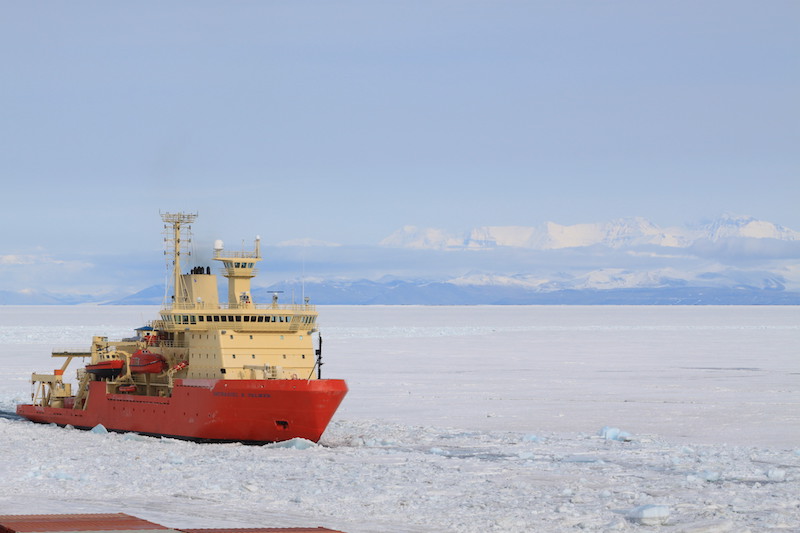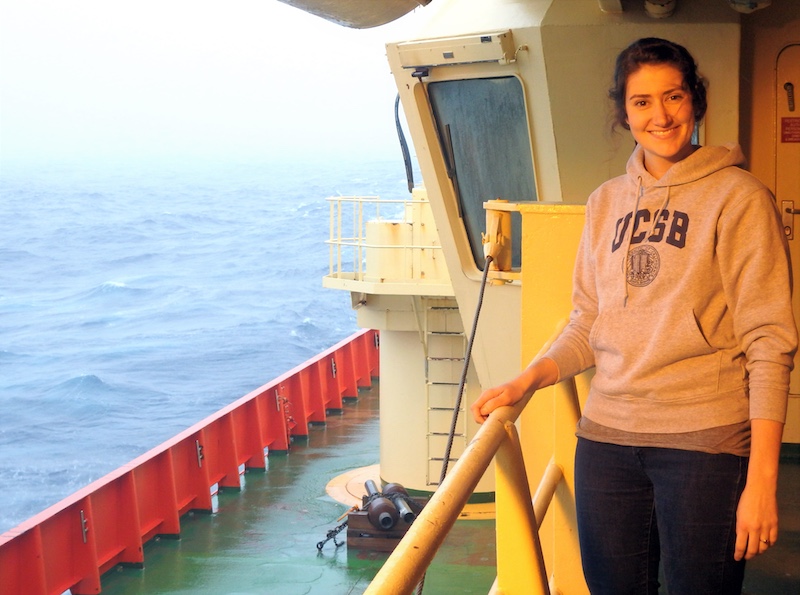
Glacial Geologist Lauren Miller Simkins studies the sediment beneath Antarctica’s ice.
What’s the coldest you’ve ever been? Where were you then?
The Nathaniel B. Palmer ship is an icebreaker — a boat designed to break ice so that the scientists on board can explore Antarctica at all seasons of the year, in any weather conditions. Glacial Geologist Lauren Miller Simkins spends one to three months at a time on this ship, working seven days a week in shifts of 12 hours. She usually gets only around five hours of sleep a night when working on the Palmer because the work that she and her colleagues do is so exciting that she “has trouble going to sleep after 12 hours.”
The icebreaker is named after Nathaniel Brown Palmer, who was born in Connecticut in 1799. He went to sea when he was just 14 years old. Palmer was one of the first people to see Antarctica, spotting it in 1820 when he was hunting seals in the southern seas.
For millions of years, Greenland (near the North Pole) and Antarctica (at the South Pole) have been covered by ice sheets. As that ice melts, fresh water is released into Earth’s oceans, raising sea levels and affecting the way the oceans’ water flows, weather systems, the world’s coasts, and much more.
Satellites show scientists changes in the cryosphere (Earth’s ice) in real time. But they’ve only existed since the 1950s — less than 100 years. In order to understand how glaciers and ice sheets behave and what they will do in the future, glacial geologists like Lauren Miller Simkins study thousands of years of the history of Earth’s ice. They collect evidence contained in sediment (gravel, sand, silt, and clay), rock, and the ice itself. This evidence — the geological record — “is important for understanding future sea levels,” says Simkins. It can help scientists and technologists create more accurate ice sheet models so that we can “project into the future.”
Her contribution? “I study the sea floors that used to be covered by the Antarctic ice sheet.” We need to know how water moves and drains beneath glaciers and ice sheets. And it’s also important to understand the conditions at the margins or edges of the ice. “We can see these processes in the geological record.” Simkins’s examinations of sediment and rocks help her infer what happened to ancient glaciers and ice sheets in the time between that of the evidence she finds in layers of sediment and rock and the present.
How can Simkins and her colleagues on the Palmer see what’s under the surface of the water? They rely on the latest technology to explore what they cannot see from the boat. Their tools send sonar (sound waves) deep into the water to learn more about what the seafloor looks like and what’s below the surface of the Earth.
Math plays an important role in this work. Knowing trigonometry and the relationships between distance, time, and speed help Simkins and other scientists use their instruments properly. The angles of the receivers sending out sound waves or photons, the speed of the boat, its “roll and heave,” wind conditions, and ocean waves affect the data collected and its meanings.
Another way Simkins and her colleagues on the Palmer learn about what lies beneath the surface of the ocean is to gather sediment cores. They send a barrel connected to their boat by a cable down to the sea floor. Once it drops through hundreds of meters, weights on the top of the barrel push it into the rocks, sand, silt, and clay beneath the water. Then scientists on the boat pull the barrel back up and examine the sediment it collected.
This sediment settled on the ocean floor from hundreds to thousands of years before the barrel pulls it up. The shapes of its grains and other materials collected with it (including ash and the remnants of plants and other life forms) provide Simkins with clues. For instance, certain sizes of sediment grains are left behind after glacial meltwater flows into the ocean. And volcanic ash is associated with ice sitting on the ocean floor that retreated further inland. Simkins and her colleagues examine sediment cores on the ship and back in their lab, looking not just at the solid material within them but also at water they squeeze out of it.

Like many of the scientists Math4Science interviews, Lauren became curious about the natural world at an early age. She grew up in Stillwater, Oklahoma, where “I spent most of my time when I wasn’t in school outside.” She “dug in the dirt, gardened, and ran around” whenever she could and “interacted with the physical environment a lot.”
“Oklahoma is a good spot for fossil hunting” and Simkins remembers being amazed at “finding a lot of fossilized marine shells” there “that should be in an ocean.” “This place” — her land-locked home state — “used to be under the ocean.” Millions of years ago, the Western Interior Seaway covered Oklahoma and beyond, stretching from Alaska to Mexico.

As she headed for college at Oklahoma State University, Simkins considered entomology or radiology but then decided that she preferred education, because it would allow her to study many different subjects. But as she completed the science requirements for her elementary education degree, she realized that was the place for her, after all.
A geology class taught her that “it was so fascinating to think about the physical world that we see every day in a completely different way and to think about what’s beneath our feet.” Groundwater particularly interested Simkins. “Sometimes” the water “that we rely on for drinking” is “kilometers below the subsurface.” Its quality “is dependent on geological processes — on the rocks or sediments that the groundwater is interacting with.”
She also enjoyed “thinking about timescale,” beyond “the seconds, minutes, days, months, years” and even centuries that people usually consider. Exploring the geological record means “thinking about thousands and millions and billions of years.” “What the Earth was like on those really long timescales was really eye-opening for me.”
Shooting sound waves and particles of light deep into the ocean and pulling up ancient sediment from the sea bed send Simkins back in time and help us understand how glaciers change.


